常寂光寺について / About

- HOME
- 常寂光寺について
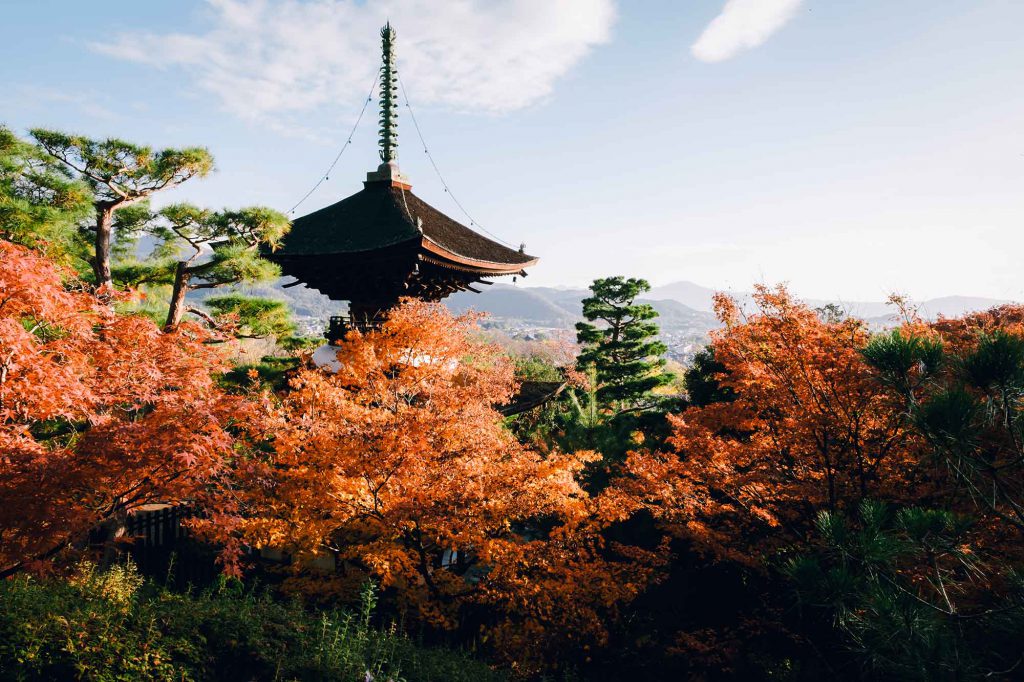
常寂光寺
慶長年間(1596〜1614)に大本山本圀寺第16世究竟院日禛上人により開創。本堂は慶長年間に小早川秀秋公の助力を得て、伏見桃山城客殿を移築し造営する。 仁王門は、元和二年(1616)に大本山本圀寺客殿の南門(貞和年間の建立)を移築、仁王像は運慶作と伝えられる。什物に高倉天皇より小督局に下賜された車琴がある。 これは小早川秀秋公より当山に納付されたものである。(非公開)
小倉山
平安時代より嵯峨野の地は、皇族や貴族の離宮、山荘をかまえる景勝地として有名であった。 特に小倉山、亀岡、嵐山の山麓は、後嵯峨上皇の亀山殿、兼明親王の雄倉殿、藤原定家の小倉山荘の他、 八条院高倉、待賢門院の中納言局、藤原公雄、藤原光経、飛鳥井雅有、覚性法親王や西行法師、涌蓮、向井去来など公家や歌人が好んで別荘や菴を構えた地域です。 後嵯峨上皇が吉野の桜を嵐山に移植してより、嵐山は桜の名所、小倉山は紅葉と鹿の名所として親しまれてきました。
小倉山山腹に位置する常寂光寺境内には、藤原定家の小倉山荘跡と伝えられる場所が仁王門北側に有ります。 又、後世に復元された山荘の基礎石跡が多宝塔の西南上方に有り、現在は時雨亭跡の石碑が建てられています。
明治時代頃までは、多宝塔の北側の墓地に前中書兼明親王の墓碑が存在しました。多宝塔の西側には、木下長嘯子の歌塚が有り、歌人としても有名であった日禛上人との交流が偲ばれます。
七重八重花は咲けども山吹の実の一つだに無きぞかなしき(後拾遺和歌集1154) 兼明親王
牡鹿なく小倉の山の裾近みただひとりすむわが心かな(山家集、上、秋歌) 西行法師
わか庵は小倉の山の近ければ浮き世を鹿と鳴かぬ日ぞなき(新勅撰集、五、秋歌下) 八条院高倉
山里はみな冬がれて小男鹿の音にぞ僅かに秋は残れる(出観集、秋歌) 覚性法親王
忍ばれむものともなしに小倉山軒端の松ぞ馴れて久しき(拾遺愚草2082) 藤原定家
Jojakko-ji Temple
It was founded by the 16th head priest of Honkoku-ji, Priest Nisshin, during the Keicho era (1596-1615). With the support of Kobayakawa Hideaki, the Guest Hall (Kyakuden) of Momoyama Castle was moved to this temple and became its main hall. The south gate (built during the mid-14th century) to the Guest Hall of Honkoku-ji temple, was moved to this temple in 1616 to serve as the Niomon gate. The Nio statues are attributed to the renowned 13th-century Buddhist sculptor Unkei (1151-1223). Among the temple treasures is a kurumagoto (small portable koto stringed instrument), which was granted to the lady Kogo-no-Tsubone by Emperor Takakura (1161-1181). The kurumagoto was then donated to this temple by Kobayakawa Hideaki. (It is not on public display.)
Mount Ogura
Since the Heian period (794-1192), the Sagano district has been famous as a scenic area where Imperial families and aristocrats erected detached palaces and mountain villas. Especially in the areas around Mount Ogura, Kameyama and Arashiyama, there were countless villas and retreats of emperors, court nobles and poets. These included retired Emperor Saga’s Kameyama Palace, Prince Kaneakira’s Ogura-den Palace, and Fujiwara Teika’s mountain villa. Since the retired Emperor Gosaga (1220-1272) transplanted cherry trees from Yoshino Mountain in Nara, Arashiyama has become famous for its cherry blossoms, along with Mount Ogura for autumn leaves and deer.On the grounds of Jojakko-ji, standing on the side of Mount Ogura, there is a site said to be the possible location of Fujiwara Teika’s villa, Shigure-tei. It was on the north side of Niomon gate. On its south-west corner are the remains of some building’s foundation stones. The villa had been reconstructed by subsequent generations over by Tahoto pagoda. A stone monument for the Shigure-tei stands there today, next to the Immortal Poets’Shrine.Until the Meiji period, the tombstone of Prince Kaneakira was in the cemetery on the north side of the Tahoto pagoda. On the west side of Tahoto pagoda stands the stone monument to the poet Kinoshita Choshoshi (1569-1649), which indicates his close relationship with Priest Nisshin, who was also known for his poetry.
In sevenfold and eightfold, yamabuki flowers are fully blossoming; what a pity, not even a single fruit is borne. (By Prince Kaneakira, Goshui Wakashu, No. 1154)
Hearing a stag calling, I look into my heart, living alone at the foot of Mt. Ogura.
Even living in a hermitage on Mt. Ogura, not a single day passes without my crying about this world along with the deer. (by Hachijo-in Takakura, Poems of Autumn, Shin-chokusenshu, Volume 5)
So desolate is this wintry mountain village, autumn remains only in the sound of a stag. (by Priest /Prince Kakusho, Poems of Autumn, Shukkanshu)
On Mt. Ogura, morning after morning a drizzling rain; yesterday maple leaves all around were tinged in faint colors.(by Fujiwara Teika, Shuiguso, No. 2082)

山門
太い角材を格子に組んで造られた山門は、江戸後期に作り変えられたもので、江戸中期出版の「都名所図会」には、袖に土塀をめぐらした薬医門が図示されています。閉門しても墨色に塗られた角柱の格子の間から参道が見える開放的な山門です。
開山
開山は究竟院日禛上人、字は尊覚と号す。権大納言広橋国光の息男として永禄四年 (1561) 京都に生まれた。幼少にして京都六条堀川の大本山本圀寺第十五世日栖上人に師事し、わずか十八歳にして同寺第十六世の法灯を嗣いた。宗学と歌道への造詣が深く、加藤清正、三好吉房、小出秀政、小早川秀秋、瑞竜院日秀 (秀吉の実姉)、その他京都町衆の帰依者も多数であった。
文禄四年 (1595)、豊臣秀吉が建立した東山方広寺大仏殿の千僧供養への出仕・不出仕をめぐって、京都の本山が二派に分裂したとき、上人は、不受不施の宗制を守って、出仕に応ぜず、やがて本圀寺を出て小倉山の地に隠栖し、常寂光寺を開創した。当地を隠栖地にえらんだのは、古くから歌枕の名勝として名高く、俊成、定家、西行などのゆかりの地であったからと思われる。当時、小倉山一帯の土地は、高瀬川開削で名高い角倉一族の所有であった。日禛上人は角倉了以の従兄である栄可から寺の敷地の寄進を受けている。
慶長十一年 (1606)、了以が丹波の物産を京都に運ぶため、丹波世木村から嵯峨に至る大堰川の浚鑿工事を行なうに、上人もまたこれに尽力を惜しまなかった。当時、上人の大檀那に備前伊部の瀬戸内水軍の旗頭である来住一族があった。上人からの依頼により来住氏配下の船頭が備前から召集され、了以の指揮に従ってその舟夫となり、丹波保津山本両村と世木村その他沿岸の諸村並に嵯峨の人々にも行舟の術を教へ、毎年開河期八月に来って翌年四月に帰国していた。当初は、寺を以てその期間の止宿所としていたが、後に角倉家の厚意にて天龍寺小字大雄寺の荒蕪地を開拓し、住居とした。現在の角倉町である。嵯峨の夏の風物となっている保津川下りの起こりである。
上人は元和三年 (1617) 八月二十二日、この地に五十七歳の生涯を終えられました。
常寂光寺と日法上人
一道院日法上人(1659~1719)は、身延山久遠寺第三十一世、京都立本寺第二十二世一圓院日脱上人の法嗣で、修法(御祈祷)を もって聞こえ、京都鴨川において一千日の荒行を厳修して洛内外の人々の信仰を集め、門前市をなすが如きであったという。 正徳二年(1712)堀川本蔵寺において霊元上皇の御悩平癒の御祈祷を修し、霊験あらたかとなり、大験者及び上人号の尊称をうけられました。以後本蔵寺は勅願所一道院と称されました。正徳五年(1715)に常寂光寺に入山(当山第十四世)、当山にも霊元上皇より多宝塔に「並尊閣」の勅額を賜わり、本堂には伏見常照院宮御筆蹟にて「御祈祷処」の扁額を賜わりました。日法上人は享保四年(1720)に当山でご遷化されたと伝えられていますが、その墓が一道院にも常寂光寺にも見当たらないことを憂いて本立寺御院首野口泰信僧正と野口政子夫人のご芳志により開山堂の建立と日法上人墓建立となりました。 本立寺の開山は、究竟院日禛上人で、開基は小笠原秀政公の生母、延壽院です。又、一道院は、野口泰信僧正の御父上がご住職をされていましたが、昭和二十年強制疎開にあい全建物を取り壊され寺域は幹線道路敷地として強制買い上げとなり再建困難となられました。以来、一道院の御本尊、什宝の一切が本立寺に移され格護されてこられました。
Main Gate
The main gate, built with rectangular timbers arranged in the lattice we see today, was renovated in the late Edo period (1603-1868). This Yakuimon-style gate was illustrated on the inner slip cover of the Miyako Meisho Zue (Guide to Famous Kyoto Sites) published in the mid-Edo period. At that time, there was a mud wall attached to the gate; after the renovation, it was removed.This gate has an open feeling to it. Even when the door is closed, one can see the approach through the widely spaced framework of the black-painted door lattice.
The Founder, Priest Nisshin
Priest Nisshin was born in 1561 in Kyoto, the son of a high-ranking aristocrat, Hirohashi Kunimitsu. In his childhood, he studied under Priest Nissei, the 15th head priest of Honkoku-ji, the head temple of the Nichiren Buddhist sect in Kyoto, located in the Rokujo Horikawa area. Excelling in academic work, Nisshin took over as the 16th head priest of the temple when he was only 18 years old. From that time on, Priest Nisshin’s reputation stood high as an outstanding leader of the Nichiren sect. Both Kyoto townsfolk and distinguished samurai warlords such as Kato Kiyomasa, Miyoshi Yoshifusa and Koide Hidemasa became devout believers. In 1595 when the Nichiren sect split into two groups over the issue of attending a Buddhist service held for the Big Buddha of Hoko-ji temple that Toyotomi Hideyoshi, the former Imperial Regent, had erected, Priest Nisshin strictly observed the teachings and regulations of the Nichiren sect, which did not accede to Hideyoshi’s enormous authority. He refused to attend the service at Hoko-ji, left Honkoku-ji and founded Jojakko-ji in 1596 here in Mt. Ogura on land donated by the head of the Suminokura family, who was a distinguished urban planner in those days. Nisshin was 36 at the time. Mt. Ogura had been a place famed for poetry from olden times, favored by such distinguished poets as Fujiwara Toshinari, Fujiwara Teika and Priest Saigyo. Because Priest Nisshin himself excelled in poetry, he chose Mt. Ogura for his retreat. In 1617, he came to the end of his life here at the age of 57.
Priest Nippo
Priest Nippo (1659-1719) was a disciple of Priest Nichidatsu, who was the 31st head priest of Minobusan Kuon-ji (the head temple of the Nichiren Buddhist sect in Yamanashi Prefecture). Nippo was the 22nd head priest of Ryuhon-ji temple in Kyoto, and was very well known for his mighty prayers and incantations. He practiced asceticism by sitting in the Kamo River for a thousand days. This act of faith attracted numerous devotees from inside and outside Kyoto, and there was always a constant flow of people to see him.
Nippo performed faith healing to aid the recovery of the retired emperor Reigen from a severe illness. The ritual was conducted at Honzo-ji temple on Horikawa Street in 1712, and it miraculously worked. Nippo was thus given the honorary titles of Daikenjya (great spiritual practitioner) and Shonin (high-ranked priest). Honzo-ji temple was designated an Imperial Prayer Temple, Chokugansho, and came to be called Ichido-in. Nippo then became the 14th head priest of Jojakko-ji temple in 1715. To commemorate this, the retired Emperor Reigen bestowed an imperial name plaque reading Heisonkaku (Pavilion of Two Respected Images) for the Tahoto pagoda. Also, a plaque reading Gokito-dokoro (Honorable Prayer Place), with calligraphy by Lady Joshoin of the princely Fushimi-no-miya family, was bestowed on the Main Hall. Priest Nippo is said to have passed away in 1719 at this temple, but no tomb has ever been found, either at Ichido-in or here at Jojakko-ji temple. With a generous donation from the present chief priest of Honryu-ji temple, Noguchi Yasunobu, and his wife Masako, who were both deeply concerned about this lack, the Founder’s Hall and Priest Nippo’s tomb were erected in 2004.
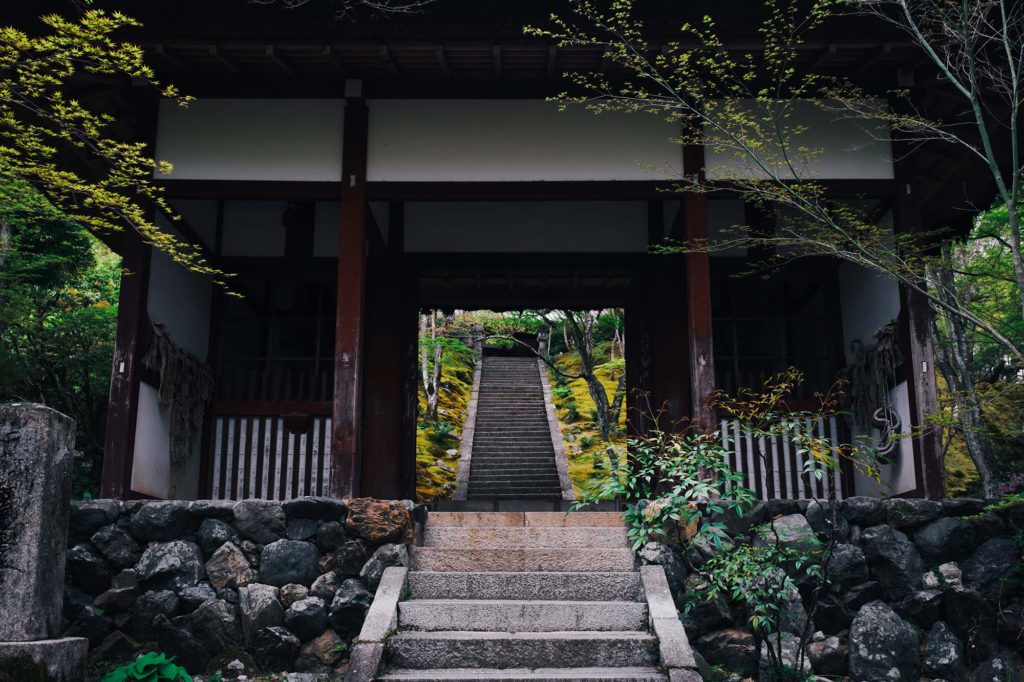
仁王門
Niomon Gate
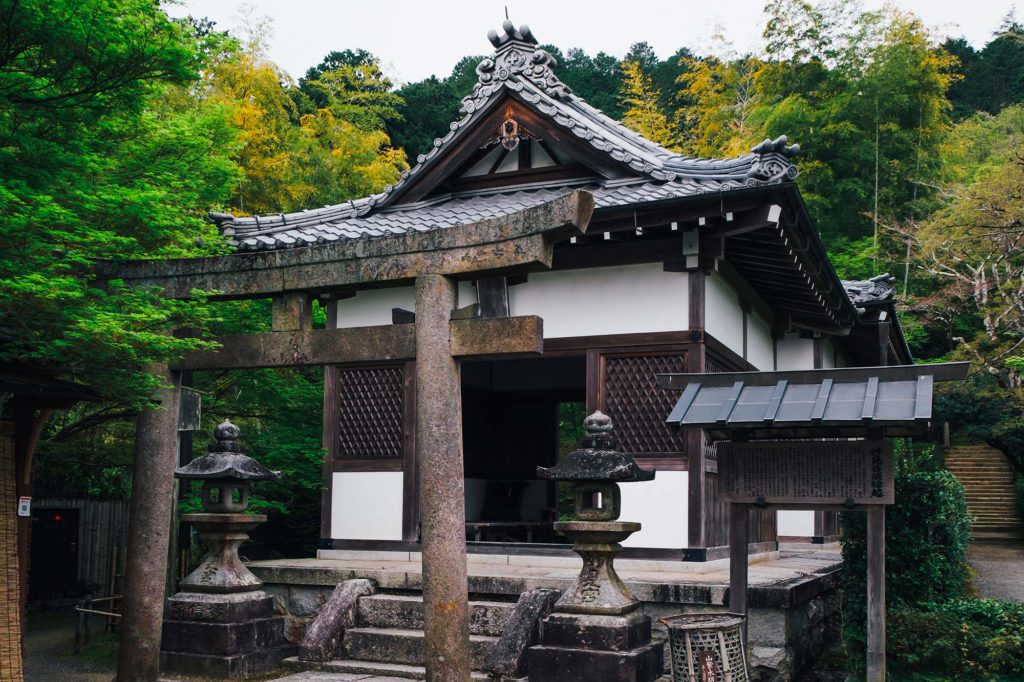
常寂光寺妙見大菩薩縁起
妙見菩薩は、北極星または北斗を象徴した菩薩様であることから、妙見尊星王、北辰妙見菩薩などといわれます。「七佛八菩薩所説大陀羅尼神咒経第二」によれば、妙見菩薩は衆聖中の最勝であり、よく国土を擁護し、また人の死を除き生を定め、福算を増益する尊星であると説かれています。平安時代以来、京都畿内に多く祭られ、諸星の王として宇宙万物の運気を司り支配される菩薩として尊崇されました。 中世には、地方の豪族により守護神として帰依されました。近世には、各藩主の帰依により多くの大衆の信仰するところとなり、豪商の帰依により、転じて商業神となり、また、安産・子孫繁栄・良縁恵与の御利益のある菩薩として広範な庶民の尊信を集めています。 その中でも洛陽十二支妙見は、江戸時代中期より皇城千年の都、京都の中心、御所の紫宸殿より十二支の酉の方角にまつられている霊験あらたかな妙見菩薩です。 當山の妙見菩薩は、慶長年間 (1596~1610) 保津川洪水の際、上流から流れついた妙見菩薩御像をふもとの角倉町の一船頭が拾い、久しく同町の集会所にお祭りされていたのを、享和年間 (1801~1803)、當山第二十二世日報上人の時に、當山境内に遷座されました。 爾来、御所から西の方角に当たることから「酉の妙見菩薩」となり、江戸時代末期から昭和初期にかけては、京都市内だけでなく関西一円から開運、厄除けの御利益を願う参拝者で大賑わいしました。第二十六世日選上人代に妙見堂を建立して以来、多宝塔の修復、第二十七世日逢上人には諸堂を修復し、第二十八世日暁上人には、妙見堂前に當山壇徒早田佐七氏より鳥居が寄進建立され、さらにその前後の灯籠は、妙信講、天人講の世話方より寄進されたもので、大黒屋・松屋・夷屋・丁子屋・木綿屋・尾張屋などの商家の屋号と施主名がみられます。 妙見堂内の大変立派な前机は、歌舞伎の役者衆による寄進で、これは「妙見」の語義が「麗妙なる容姿」と解せられて役者や花街の女性に尊信されたことによります。 文政から天保、弘化年間 (1818~1846) は、「酉の妙見様」の隆盛期となり、當山の護持にもおおいに寄与されました。 第四十二世日憲上人代にも妙信会、婦人会の講が當山壇信徒と地元の商家により結成され、昭和三年に妙見堂拝殿が建立され、昭和八年には玉垣が寄進されています。 第四十四世日涛代には、壇信徒のご寄付と拝観収入により昭和四十九年に妙見堂本殿と拝殿の大改築がされ、平成十八年には、屋根瓦の葺きかえと格天井の修復がされました。このように常寂光寺の歴史とともに年々立派に護持されてきた妙見様です。 ご参拝の折りには妙見堂へ是非ともお参りください。
History of Myoken Bodhisattva in Jojakko-ji Temple
The “Dhāraṇī Jinju Sutra Preached by Seven Buddhas and Eight Bodhisattvas, Part 2” expounds that the Myoken Bodhisattva is the most eminent among all revered figures, and is thus regarded as a Sonjo, or sacred star, that protects the whole country. The sacred star is further said to vanquish death, enhance vital forces and increase one’s balance-sheet of happiness.Since the Heian period (794-1192), the Myoken Bodhisattva has been greatly respected as the chief of the stars, who presides over the fortune of all things in the universe. There are a number of temples which enshrine Myoken Bodhisattva in Kyoto and the nearby prefectures. In the Middle Ages, the Myoken Bodhisattva was embraced by powerful regional clans as their guardian deity.In early modern times, following the lead of several local lords who took refuge in Myoken Bodhisattva, many commoners also became believers. With the growth of the wealthy merchant class, the Myoken Bodhisattva turned into a god of commerce. It also came to attain widespread respect as a Bodhisattva who has beneficial power for easy births, prosperity and good marriages.Since the middle of the Edo period (1603-1868), the twelve temples which enshrine Myoken Bodhisattva, situated in the twelve directions from the Imperial Palace of Kyoto, have been designated as Rakuyo Junishi Myoken (Myoken of the Twelve Chinese Zodiac Temples in Kyoto) and considered to be especially powerful. Jojakko-ji temple is one of them, located in the direction of the Rooster (west). The Myoken Bodhisattva statue in this temple was found during the Keicho era (1596-1610) by a boatman living in Sumikura-cho, when the Hozu River flooded and the statue was mysteriously washed ashore. For years it was enshrined in the public assembly hall of Sumikura-cho district. It was transferred to this temple at the time of the 22nd priest (also named Nippo), at the beginning of the 19th century. Since then, it has been called “Tori-no-Myoken Bosatsu (the Myoken Bodhisattva in the direction of the Rooster).” Over the years from the end of the Edo period to the beginning of the Showa (1925-1987), the temple was bustling with worshippers, not only from Kyoto but also from the whole of Western Japan, who prayed for good luck and to ward off evil.
In the time of the 26th chief priest, Nissen (?-1857), Myoken-do hall was constructed. During the time of the 28th priest, Nichigyo (?-1860), the torii gate in front of Myoken-do was donated by Hayata Sahichi, one of the followers, and four stone lanterns placed inside and outside the torii gate were donated in 1845 by the believers’ groups, Myoshinko and the Tenjinko. The names of individual and shop donors are engraved on the lanterns, including old establishments like Daikokuya, Matsuya, Ebisuya, Chojiya, Momenya and Owariya.
As the name “Myoken” can also be interpreted to mean “beautiful features,” actors and actresses as well as women working in the entertainment quarters worship this deity. An exquisite table, placed before the altar in the hall, was donated by kabuki actors. The popularity of Tori-no-Myoken soared during the Bunsei, Tenpo and Koka eras (1818-1846) and greatly contributed to the protection of Jojakko-ji temple. In the time of the 42th priest, Nikken (1878 -1942), the Myoshin-kai group and a women’s association were formed by the followers and local merchant families. The Myoken-do Worship Hall was added in 1928 and the fence around it was donated in 1933 by believers. In the time of the 44th priest, Nitto, in 1974, the main hall and the Myoken-do Worship Hall were entirely refurbished with donations from devotees and supporters as well as income from the admission fee. In 2006 their roof tiles were renewed and the lattice-ceilings were restored. In this way Myoken-do hall has been maintained and refined along with the history of Jojakko-ji temple. When you come to the temple, you really must visit Myoken-do.
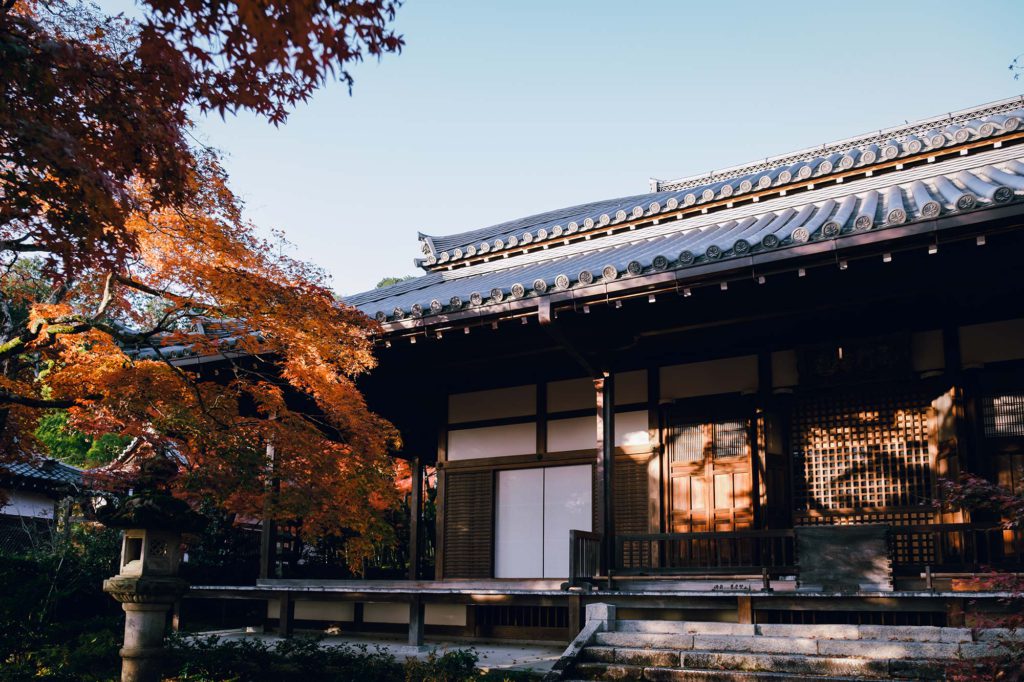
本堂
本堂は、第二世通明院日韶上人(日野大納言輝資の息男)代に小早川秀秋の助力を得て、桃山城客殿を移築して本堂としたもの。江戸期の文献、資料に図示された本堂の屋根は、本瓦葺きの二層屋根となっている。現在の平瓦葺きの屋根は、昭和七年の大修理の時に改修されました。建立の年代は、慶長年間。
鐘楼
鐘楼は、寛永十八年 (1642) 当山第四世、光照院日選上人の建立。梵鐘は第二次世界大戦中徴資に遭い、現在の梵鐘は、昭和四十八年に青木一郎博士の音響設計により、古律黄鐘調の新鐘として鋳造されたもの。毎日、正午と夕方五時に所定の数を突いています。
Main Hall
With the financial support of Kobayakawa Hideaki during the Keicho era (1596-1615), the Guest Hall (Kyakuden) of Momoyama Castle was moved to Jojakko-ji temple to serve as its main hall. This was the time of the 2nd priest, Nisho. According to illustrations found in literature and other material from the Edo period, the Main Hall had a two-layered hon-gawara-style roofing (the style using round and flat titles overlapping alternately). When major repairs to the Main Hall took place in 1932, it was converted to the present hira-gawara-style roofing (the style using flat tiles only).
Belfry
The belfry was constructed by the 4th chief priest, Nissen, in 1642. The original temple bell was appropriated during World War II to make use of its metal. The present bell was cast in 1973 under the design and supervision of Dr. Aoki Ichiro. It has the classic style of acoustics called ojikicho. Every day, the bell is struck at noon and at 5 pm.
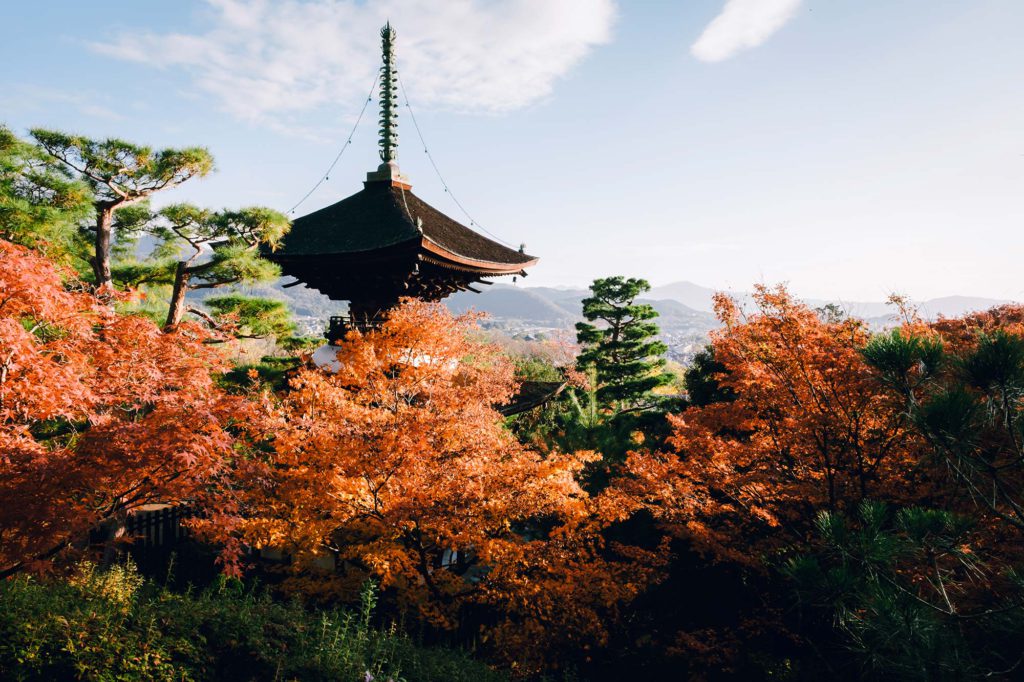
多宝塔
常寂光寺の多宝塔、中村 昌生。
寺伝に、文禄五 (1596) 年日禛上人が、当寺に隠棲して堂舎を建立し、さらに日韶上人が小早川秀秋の助力を得て桃山城客殿を移築して本堂とし、元和二 (1616) 年には本圀寺客殿南門を移して仁王門としたことが見えるから、慶長から元和にかけての頃が、当時の創建期であったらしい。
時雨亭跡
定家山荘の場所については、諸説ありますが、常寂光寺の仁王門北側から二尊院の南側に有ったと伝へられています。 この場所には、室町時代頃から定家卿の御神像を祀る祠が有りましたが、常寂光寺を創建する時に、定家卿の祠よりも上に寺の庫裏を建てるのは恐れ多いと現在の場所に遷座されました。 明治時代までは、小さな祠でしたが、明治23年に現在の大きさの建物に改築され、歌遷祠と呼ばれるようになりました。 歌遷祠の扁額は、富岡鐡齋の作。南隣に位置する時雨亭跡は、戦前までは庵室が建っていましたが、台風により倒壊してしまい、その後再建出来ず現在に至ります。 この庵室は、いつごろ建てられたか不明ですが、当山の古文書「双樹院日勝聖人傅」(1728年)の境内図には、この位置に庵が描かれています。又、「都名所図会」(1780年発行)にも庵が図示されていることから、江戸時代中期には建てられていたことが分かります。
Tahoto Pagoda (Two-storied pagoda)
According to the Hoke-kyo (Lotus Sutra), when Shaka Buddha was preaching, the ground cracked open and a stupa appeared from below.
From inside the stupa a voice emanated saying “Wonderful, wonderful, Sakyamuni Buddha. Your sermon is the truth.” That was Taho Nyorai (the Buddha of the Past) proclaiming the truth of Shaka’s words. Hence, traditionally the temples which practice the chanting of the Lotus Sutra build Tahoto pagodas. The sutra also states that Taho Nyorai invited Shaka into the stupa where they sat side by side to preach.
Old Shigure-tei Site and Immortal Poets Shrine
There are several opinions about where the exact location of Shigure-tei, the poet Fujiwara Teika’s (1162-1241) mountain villa, used to be. It is believed to have been located somewhere between the north side of Niomon gate and the south side of the adjacent Nison-in temple.
In this same area there originally used to be a small shrine built some time during the Muromachi period (1392-1573), dedicated to Teika with his statue inside. Later, when Jojakko-ji temple was erected in 1596, the monks’ living quarters turned out to be located higher than this august shrine, so it was moved to the present site, higher on the hillside. At first, it was a miniature shrine, but was rebuilt in its present size in 1908. It has been called the Immortal Poets’ Shrine (Kasenshi) since then. The name plaque was written by the well-known ink painter Tomioka Tessai (1837-1924).
There also used to be a hermitage on one of the possible old Shigure-tei sites, immediate south of the Immortal Poets’ Shrine. It was destroyed by a typhoon in the early 20th century and has not been rebuilt. The construction date of this hermitage is unknown, but a map of the temple grounds included in an old document housed in this temple, Story of Sojuin Priest Nissho (1728), has an illustration of a hut in this location. The same building is also shown in Guide to Famous Kyoto Sites (1780). This proves that it was here as early as the mid-18th century.
